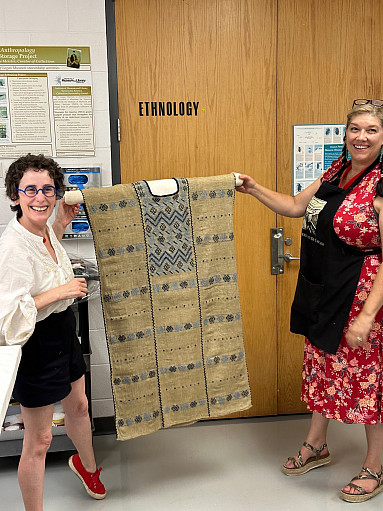Related Links
Testimonials
Here’s what participants had to say when asked, “what was the most valuable aspect of the course?”


Somethings can’t be learned on your own – this took the guesswork out of treatments and processes I’ve only read about before. (Mary Leverance, Preservation and Conservation Coordinator, Libraries and Center for Advanced Spatial Technologies, University of Arkansas)
Knowledge about paper and treatments will help guide decision making for treatments I can perform at work. Practical application and hands-on skills mean I can start mending and repairs as soon as I get back to work. (Mary Leverance, Preservation and Conservation Coordinator, Libraries and Center for Advanced Spatial Technologies, University of Arkansas)
I’ll be able to better evaluate conservation issues in our collection and know what I can and can’t attempt. (Malia Sbach, Museum Technician and Registration Assistant, Thomas Jefferson Foundation, Inc.)
I am excited to head back to my institution and set up space where I can start properly surface cleaning paper materials and where I can correctly remove the tape and mend tears. These skills will be instrumental in helping us identify what can be repaired in-house versus sent to a conservator. (Chelsea Morris, Museum Registrar, Casemate Museum)
I can take the knowledge and techniques shared in class and utilize them within my work practice. I learned new methods of washing and tape removal that I have not tried previously. (Rebecca Philio, Conservation Technician, Boston Public Library)
I’ll be able to make custom mounts without outsourcing! (Nola Berish, Assistant Curator of Exhibits and Technology, Tampa Bay History Center)
I will be able to do mounts in-house without having to outsource, which will save my museum time and money. (Amanda Weyer, Exhibits Manager, California Museum)
Knowledge to supply my shop with the correct tools and supplies. Great new techniques learned. (Schuyler Maehl, Head Preparator, Museum of Science and Industry)
Invaluable new knowledge and skills that will help my institution plan, write grants, and create much better storage solutions for our materials. (Jennifer St.Germain, Collections Manager, Glenn A. Black Laboratory of Archaeology, Indiana University)
I have more confidence in decision making after gaining formal training. (Andy Gabrysiak, Art Handler, North Carolina Museum of Art)
Having an instructor who knew the ins and outs so well. We often went over a “best-case scenario” and then “realistic” situations. Her expertise in materials and their characteristics was incredibly impressive. It was the perfect amount of learning via lecture and learning hands-on. (Christa Story, Collections Manager and Exhibition Coordinator, Wright Museum of Art)
C3 fills a need in the museum community for working professionals and students who would like to further develop their skills but otherwise wouldn’t have the opportunity because they are engaged in work or study full time. The most valuable asset of the course I took was the ability to block off time from my full-time job to devote my energy to one specific type of collections care activity. Lectures and reading provide important content and context, but I’ve found having the time and space to handle objects and do the work myself is the best way to actually acquire new collections care skills which I can then bring back and apply to my own work. The C3 model works because it is just the right length of time: short enough to justify taking time off to take the course, but long enough to actually feel like you have time to absorb the information and get enough practice to gain some level of proficiency in your chosen topic. (Caitlin Hepner, Museum Technician, Thomas Jefferson Foundation, Inc.)
I am now empowered to assess and address the needs of textiles in my collection. I have an understanding of their properties, condition concerns, and storage/display needs. I know a few simple treatment techniques, but also have the context to know when to reach out to a conservator and vocabulary to discuss treatment options with them. My instructor also provided me with tons of resources for further research! (Caitlin Hepner, Museum Technician, Thomas Jefferson Foundation, Inc.)
The instructor was helpful, friendly, and honest which made this class a great joy. I also learned a lot and enjoyed the hands-on activities that were sent to us. It was all very organized and allowed me to take the course while being able to travel or work on projects at my own pace since it was online. It was a perfect fit for me, and I am so glad I got this chance to take the class.
Both the hands-on activity kits and the live instruction were very valuable. Getting to practice or test materials and interact with the materials in the kits added wonderfully to the online instruction. The instructor kept the technical aspects of the course interesting and entertaining with funny slides and made sure the information was at a level that those of us without science backgrounds could easily understand. The videos were a wonderful addition to the readings, as were the personal examples the instructor used in her presentations.
I loved this course. It was super organized, clear, and very, very informative! i am so glad that I took it. I want to learn so much more… thank you Christa for showing us how much thought and care it goes into tackling collection care!
GREAT CLASS can not wait to the next one!